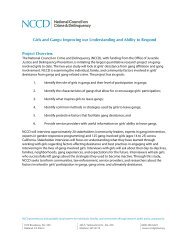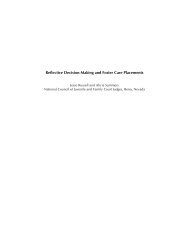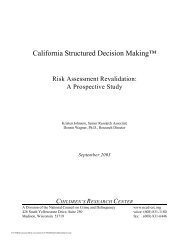Evaluation of the Insight Prison Project - National Council on Crime ...
Evaluation of the Insight Prison Project - National Council on Crime ...
Evaluation of the Insight Prison Project - National Council on Crime ...
Create successful ePaper yourself
Turn your PDF publications into a flip-book with our unique Google optimized e-Paper software.
Quantitative Survey: Is Emoti<strong>on</strong>al<br />
Well-being Associated With<br />
Participati<strong>on</strong> in IPP?<br />
The impact <str<strong>on</strong>g>of</str<strong>on</strong>g> IPP <strong>on</strong> its participants was measured<br />
relative to dosage; that is, <str<strong>on</strong>g>the</str<strong>on</strong>g> total number <str<strong>on</strong>g>of</str<strong>on</strong>g> m<strong>on</strong>ths<br />
enrolled in IPP courses. 12 The sample was divided into<br />
two groups: those with higher dosage (six m<strong>on</strong>ths<br />
or more total IPP experience) compared to those<br />
with lower dosage (less than six m<strong>on</strong>ths total IPP<br />
experience). Program evaluati<strong>on</strong> literature and IPP<br />
staff indicated that six m<strong>on</strong>ths would be <str<strong>on</strong>g>the</str<strong>on</strong>g> minimum<br />
amount <str<strong>on</strong>g>of</str<strong>on</strong>g> time needed to bring about a measurable<br />
cognitive behavioral change in participants. NCCD<br />
hypo<str<strong>on</strong>g>the</str<strong>on</strong>g>sized that higher dosage (more time in<br />
IPP courses) would be associated with healthier<br />
functi<strong>on</strong>ing.<br />
Main Yard vs. H-Unit. For two reas<strong>on</strong>s, dosage<br />
analysis focused <strong>on</strong> Main Yard ra<str<strong>on</strong>g>the</str<strong>on</strong>g>r than H-Unit<br />
participants. From <str<strong>on</strong>g>the</str<strong>on</strong>g> standpoint <str<strong>on</strong>g>of</str<strong>on</strong>g> rigorous<br />
methodology, Main Yard participants provided<br />
a str<strong>on</strong>ger sample for analysis; <str<strong>on</strong>g>the</str<strong>on</strong>g>re was more<br />
c<strong>on</strong>sistency regarding <str<strong>on</strong>g>the</str<strong>on</strong>g>ir age, sentence length,<br />
time served, and time in IPP. Main Yard participants<br />
were older, had l<strong>on</strong>ger sentences, have served more<br />
time, have had more IPP experience, and were more<br />
c<strong>on</strong>sistent in <str<strong>on</strong>g>the</str<strong>on</strong>g>ir attitudes toward IPP. Sec<strong>on</strong>dly,<br />
interviews with experienced stakeholders observed<br />
that Main Yard pris<strong>on</strong>ers tend to be more mature, and<br />
more likely to quickly build trust and camaraderie in<br />
class. These are significant distincti<strong>on</strong>s since trust <str<strong>on</strong>g>of</str<strong>on</strong>g><br />
both <str<strong>on</strong>g>the</str<strong>on</strong>g> IPP staff and fellow pris<strong>on</strong>ers is crucial for<br />
IPP class success. While <str<strong>on</strong>g>the</str<strong>on</strong>g> six-m<strong>on</strong>th dosage cut<str<strong>on</strong>g>of</str<strong>on</strong>g>f<br />
was likely to identify two distinct groups <str<strong>on</strong>g>of</str<strong>on</strong>g> Main<br />
Yard pris<strong>on</strong>ers, it was unlikely that <str<strong>on</strong>g>the</str<strong>on</strong>g> same cut-<str<strong>on</strong>g>of</str<strong>on</strong>g>f<br />
was likely to distinguish H-Unit pris<strong>on</strong>ers. Pers<strong>on</strong>al<br />
characteristics and histories were expected to play<br />
a larger role in how well <str<strong>on</strong>g>the</str<strong>on</strong>g>se pris<strong>on</strong>ers took to IPP<br />
courses and how so<strong>on</strong> positive impacts might be<br />
observed. It was not expected that <str<strong>on</strong>g>the</str<strong>on</strong>g> final interview<br />
approved by CDCR would allow for <str<strong>on</strong>g>the</str<strong>on</strong>g> level <str<strong>on</strong>g>of</str<strong>on</strong>g> analysis<br />
necessary to produce measurable differences by<br />
dosage am<strong>on</strong>g H-Unit participants.<br />
A 130-item survey was created to explore statistical<br />
associati<strong>on</strong>s between IPP participati<strong>on</strong> and <str<strong>on</strong>g>the</str<strong>on</strong>g> desired<br />
cognitive outcomes. The survey c<strong>on</strong>sisted <str<strong>on</strong>g>of</str<strong>on</strong>g> questi<strong>on</strong>s<br />
about demographics and IPP participati<strong>on</strong>, followed<br />
by adapted versi<strong>on</strong>s <str<strong>on</strong>g>of</str<strong>on</strong>g> six psychological scales.<br />
Participants were asked to rate <str<strong>on</strong>g>the</str<strong>on</strong>g>mselves in <str<strong>on</strong>g>the</str<strong>on</strong>g> areas<br />
<str<strong>on</strong>g>of</str<strong>on</strong>g> emoti<strong>on</strong>al well-being, aggressi<strong>on</strong>, and decisi<strong>on</strong>making<br />
processes, and to provide <str<strong>on</strong>g>the</str<strong>on</strong>g>ir perspectives<br />
<strong>on</strong> <str<strong>on</strong>g>the</str<strong>on</strong>g> dynamics <str<strong>on</strong>g>of</str<strong>on</strong>g> classes.<br />
Scales. Six scales were adapted to create <str<strong>on</strong>g>the</str<strong>on</strong>g> survey:<br />
The Rosenberg Self-Esteem Scale 13 measured<br />
participants’ self-esteem, which IPP c<strong>on</strong>siders a crucial<br />
element <str<strong>on</strong>g>of</str<strong>on</strong>g> cognitive behavioral rehabilitati<strong>on</strong>. Scores<br />
could range from 0 (lowest degree <str<strong>on</strong>g>of</str<strong>on</strong>g> self-esteem) to 4<br />
(highest).<br />
The Buss Perry Aggressi<strong>on</strong> Questi<strong>on</strong>naire 14 measured<br />
participants’ levels <str<strong>on</strong>g>of</str<strong>on</strong>g> anger and aggressi<strong>on</strong>. Scores<br />
could range from 0 (highest degree <str<strong>on</strong>g>of</str<strong>on</strong>g> aggressi<strong>on</strong>) to 4<br />
(lowest).<br />
Social Problem-Solving Inventory 15 assessed how<br />
participants define, evaluate, and resp<strong>on</strong>d to<br />
perceived problems. Scores could range from 0 (most<br />
negative answer) to 20 (most positive) <strong>on</strong> <str<strong>on</strong>g>the</str<strong>on</strong>g> overall<br />
scale, and from 0 to 4 <strong>on</strong> <str<strong>on</strong>g>the</str<strong>on</strong>g> five subscales.<br />
Multi-dimensi<strong>on</strong>al Scale <str<strong>on</strong>g>of</str<strong>on</strong>g> Perceived Social Support 16<br />
measured <str<strong>on</strong>g>the</str<strong>on</strong>g> level <str<strong>on</strong>g>of</str<strong>on</strong>g> emoti<strong>on</strong>al support participants<br />
felt <str<strong>on</strong>g>the</str<strong>on</strong>g>y received from various sources. Scores could<br />
range from 0 (most negative answer) to 4 (most<br />
positive).<br />
The Beck Hopelessness Scale 17 measured participants’<br />
attitudes about <str<strong>on</strong>g>the</str<strong>on</strong>g> future. Scores could range from 0<br />
(highest degree <str<strong>on</strong>g>of</str<strong>on</strong>g> hope) to 4 (lowest).<br />
NCCD promotes just and equitable social systems for individuals, families, and communities through research, public policy, and practice.<br />
Page 9









